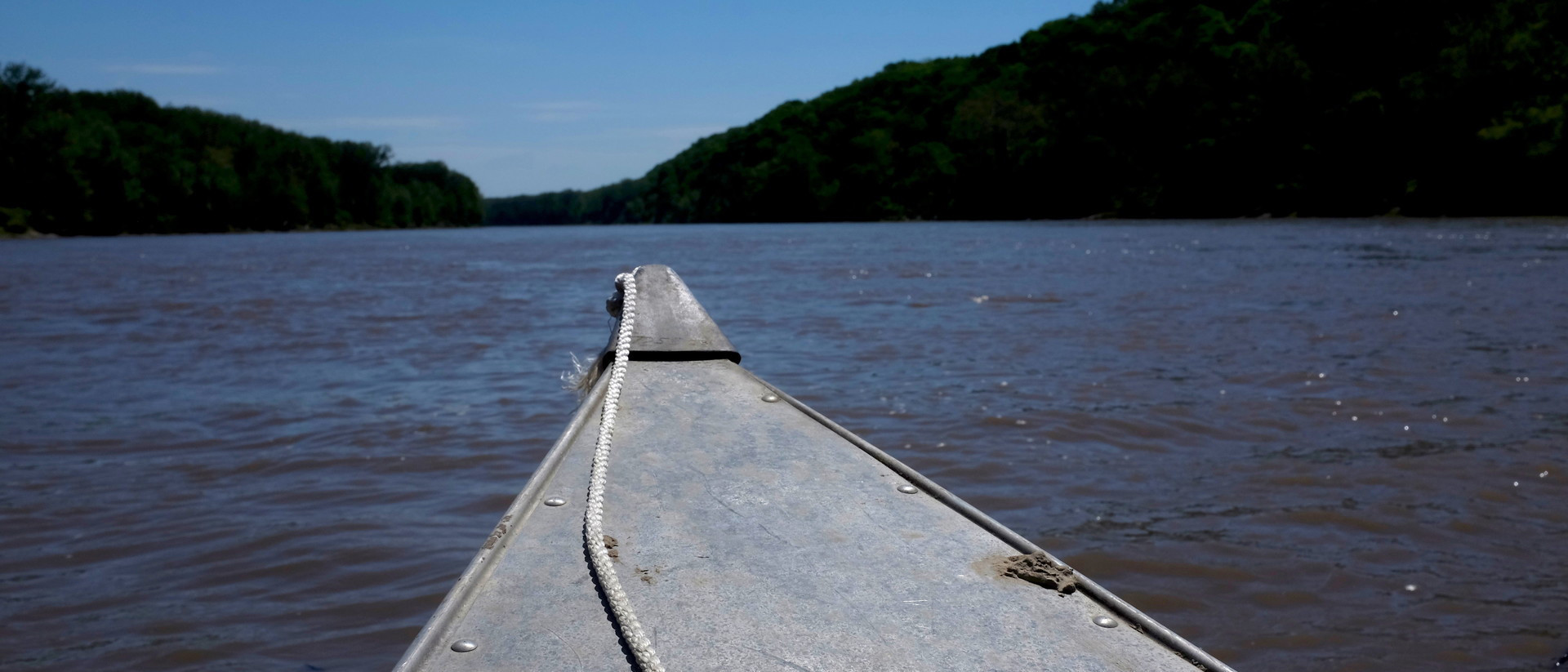After a few hours on the water, the river starts to hum lullabies. Stop paddling and you’ll hear them. Close your eyes, the Missouri whispers. See? No danger here. Just drift, peacefully, like an uprooted tree...
We’d decided to play explorer, my American friend and me. We bought a banged up aluminum canoe for $200. It was 15 feet long with a picture of a grizzly on the bow. We packed it with cans of Budweiser, a couple of tents, and our navigation charts from the US Army Corps of Engineers.
My traveling companion had grown up in a small town in the area. He wore a leather cowboy hat, knew the land, but he’d never canoed the Missouri. People don’t do that here.
We were a little worried. People had warned us the current was swift and treacherous. The river is known with good reason as “the mighty Missouri.” I’d read about flying carp – fish as heavy as sacks of potatoes that leap out of the water when startled and can knock a grown man out of a boat – and the infamous Chain of Rocks rapids just before St. Louis.

The Missouri is the country’s longest river. It rises in the Rockies and flows for 2,540 miles, all the way to St. Louis, where it bends around the city and then merges with the Mississippi. I wanted to float down the last 80 miles of the river to the confluence and then see the city I’d lived in go by one last time.
In the town of New Haven, we pushed our boat out into the current. The banks were flooded, the levees under water; all you could see were eddies. Tree trunks floated by at a jogger’s pace. We jumped into our canoe like beginner bobsledders, trusting to fate, and started paddling like demons toward the center of the current.
Once we got there, peace overcame us. When everything around is moving at the same speed you are, you don’t notice how fast you’re going. The Missouri felt like a lake. “The river is lulling us to sleep,” I murmured, as New Haven disappeared from view at upwards of 6 mph.
Two explorers take a trip
More than 200 years ago, two mythic American explorers sailed up this river. Meriwether Lewis and William Clark’s Corps of Discovery trip is known as the first US expedition to the West.
They left St. Louis in May 1804, but headed in the opposite direction we were – against the current, toward terra incognita – in a large rowboat with a party of 33 on board. They included an enslaved man, York, and a captive Indian woman, Sacagawea.
During our trip, it was hard not to think of Lewis and Clark – mainly because every place they’d ever taken a leak or stopped for a sandwich was marked with a plaque or a statue.
But I was also surprised to see that, viewed from the river, America didn’t seem to have changed much at all in 200 years. That’s because the government bought up so much land along the banks. Today they’re largely lined with nature reserves, even in the cities. The Missouri might as well have been the Amazon.
We did pass the occasional bridge or old factory or dilapidated power plant. And there were other signs of human life – the odd gunshot in the distance. Once, a boat approached ours. Aboard were two armed men. “Turkey hunters,” said my friend, who also likes to hunt. As they drew up alongside us, he put on his country accent, signaling to the natives we were OK.
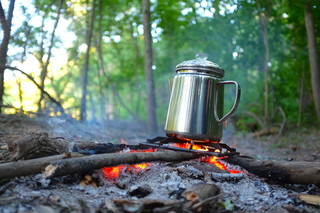
Most of the time, though, there was no one around. There were only the eagles overhead, and sometimes – or was it an illusion? – the shadow of a giant catfish under the canoe. Here, America was made up of three colors: the blue of the sky, the brown of the water, and the green of the wooded banks.
We camped in those woods. We gathered kindling, had a beer, and twisted the dial of an old radio, searching for stations. At night, we dreamed uneasy dreams fed by the angry sloshing, the creak of driftwood, the muted splash of a monstrous fish. In the morning, when the mist lifted, we saw the tracks of animals along the shore: deer, coyotes, raccoons, all together, like in paradise. Back on the water, we were alone again.
“The river is ours,” we said to each other.
The American dream: this land is our land
Our river, our land – that possessive pronoun encapsulates the story of the United States. That’s the ultimate American dream – the fantasy that all this endless space belongs to you. It’s the idea of being like Adam and Eve in paradise, the only human beings around.

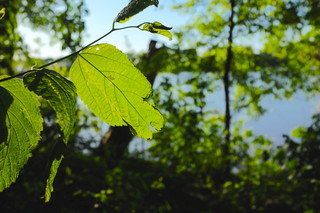
The dream is not an innocent one. “It is the dream of total power,” the Trinidadian author V.S. Naipaul wrote in his short essay on the discovery of America, “Columbus and Crusoe.” And the discovery of paradise is usually accompanied by the urge to possess it.
Just one thing: There usually turn out to be other people in paradise already. Even Robinson Crusoe came across someone on his desert island. He named him Friday and immediately instructed the man to call him Master. After all, Crusoe had gotten there first; the relationship needed to be made clear.
“Discovery” is a tainted word, as we see in the story of Lewis and Clark, whose journals I read on the trip. They were under official orders from President Thomas Jefferson to find a water route to the Pacific. Nearly three years later, believed dead, they returned. They brought journals containing accounts of hunger, freezing cold, heat, snowstorms, bears, mosquitoes, and hostile Indians, but not the mythical route to the sea. The Missouri stopped at the mountains.
“I reflected that I had as yet done but little, very little indeed, to further the happiness of the human race,” wrote Meriwether Lewis, the expedition’s leader, upon his return.
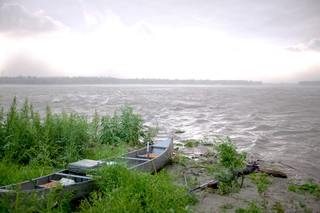
He later took to drinking, amassed debts, and became a drug addict. He died at 35 of a gunshot wound, a likely suicide.
What was more, the territory the explorers discovered had already been inhabited for some 9,000 years. According to Native American tradition, many Indians viewed the Americans as barbarians. They barely washed, stank, ate dog and horse meat. Sometimes they shot animals dead for fun.
And Lewis and Clark were far from the first Europeans to show up. French trappers and fur traders had preceded them by decades (as recounted in the film The Revenant, set on the Missouri). The pair encountered tribes that had horses marked with Spanish brands.
Meanwhile, Lewis and Clark consistently called the Indians they met “savages” in their journals, And Jefferson, who commissioned the expedition, once described native Americans as animals to be chased away.
Half a century after Lewis and Clark’s trip, many of the tribes that had lived along the river had been wiped out or driven from their land. Lewis and Clark’s groundwork facilitated the genocide.
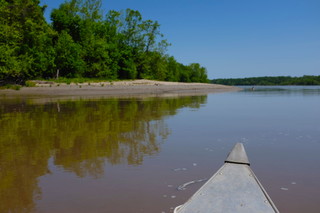
None of this was mentioned on the plaques we saw along the Missouri. Instead, the historical markers told a tale of two heroes charting the first highway out west. It’s the story many Americans learn in school: that the country was truly discovered not by the Italian Christopher Columbus (not to mention the Native Americans already living there), but by the American explorers Lewis and Clark. Their journals stand as “the unofficial Odyssey of American history,” according to the introduction in my abridged edition.
It’s myths like this that lull the country to sleep, as bizarre as they seem, certainly to the descendants of the survivors of genocide. The Native American writer Debra Magpie Earling tells us in an essay what the thousand Lewis and Clark signs say to her: Here – and over there, too – we discovered you.
Another Native American writer, Roberta Conner, calls the expedition an occupation masquerading as exploration. For her, the signs mark the trail of a genocidal purge.
This is our land – go away. That’s the bitter beginning of the American dream – and for “our,” read belonging to the descendants of the first white European colonists.
For that matter, look at the Declaration of Independence of 1776, which contains that famous line about all men being created equal. A fine idea, to be sure, but “all men” evidently didn’t include black slaves, of whom co-author Thomas Jefferson, for one, owned hundreds.
Or as the legal scholar Michelle Alexander recently put it: “This nation was founded on the idea that some lives don’t matter.”

The distortions of the past are alive and well
This was what surprised me most when I moved to St. Louis two years ago: How fundamental and persistent that idea still is. A month after my arrival, this forgotten city became world news when the black teenager Mike Brown was shot to death by a police officer. Here, in a city surrounded by Trump supporters, #BlackLivesMatter went from being a hashtag to a popular protest movement. It was here I saw my first shooting and tasted tear gas.
But more than anything, it was the everydayness of inequality that got to me. It was constantly seeing the stress and grief on the faces in the streets of this city, where a third of the population lives below the poverty line, and where everyone seems to know somebody who’s been murdered. Or as Sarah Kendzior recently put it: “St. Louis is a sprawling metropolis that feels like a small town because many tend to know someone who has been murdered, or know their relatives or friends.”
You’d have to shut your eyes not to see that grief and stress are sorted along color lines here.
But this land of racial inequality was invisible from the river. The splendid illusion of pristine innocence stayed intact well past the St. Louis city limits, where nature in all its discretion still provided a screen.
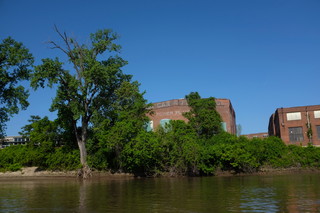
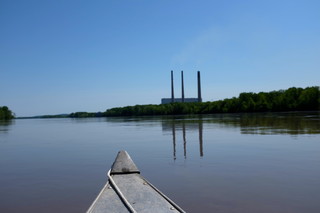
People I met in St. Louis
Along the way, I thought of the day my son was born, in a hospital somewhere beyond the greenery, in a ward that seemed to be otherwise reserved for black teenagers giving birth. And I thought of a father-to-be – he must have been about 16 – who I overheard in the hall talking on the phone to a friend. As his girlfriend audibly gave birth on the other side of the door, he said he was thinking of ending the relationship. What kind of future would that baby have – that child born at the same time and place as my son, and with the same nationality?
I also thought about a guy I met on one of my bike rides through the city. He was in his mid-20s, a philosophy student and fellow writer. He lived in a neighborhood I didn’t dare venture into at first, even in the daytime. He read massive numbers of books – or rather, he listened to them, playing audiobooks while working the jobs he had to do to pay for school. His older brother was in prison for manslaughter (wrongfully, my friend said).
His life was radically different from mine. I was curious about his world, but he preferred to talk about writers like Jorge Luis Borges. He came to my birthday party but didn’t say much. I only found out later that he’d been robbed at gunpoint outside his house that same week. He hadn’t wanted to spoil the party.
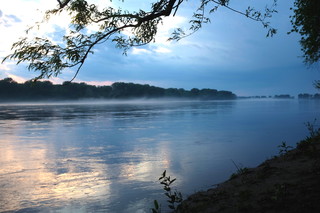
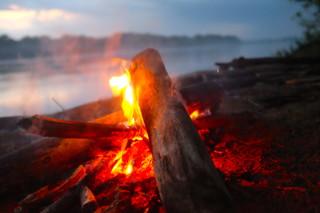
Another time, he came over soon after my son’s birth. I was jokingly singing the national anthem as a lullaby. My friend sang along, but he changed the last line, about the “land of the free and the home of the brave,” so it ended “the home of the slaves.”
The perfect storm sweeping America
I laughed, but it was more than just a joke. To my friend, the “land of the free” idea often seems farcical. He’s written poetry on the subject; his latest, self-published collection is called Black Lives Splatter.
I’m back home in the Netherlands now, and as I write, the Black Lives Matter movement is demonstrating again – or, still, as it has been for three years, since the first smartphone videos emerged showing a violence that’s as old as the country itself. The undercurrent has persisted in spite of a longtime civil rights movement and even a black man in the White House.
Terrorists have hijacked the hashtag, though: recent months have seen a number of attacks on police, one during the protests in Dallas, another near the site of demonstrations in Baton Rouge. To someone like Donald Trump, they’re grist for the mill.
A perfect storm appears to be brewing, and gathering strength.
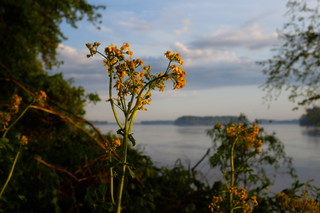
Over the past year, Trump has shocked the world. He’s called Mexicans rapists, declared it a shame that police couldn’t use more force against black protesters, and said he wanted to close the borders to Muslims. He’s obviously set his sights on white voters. And as of last week, his likelihood of winning the presidency was estimated at 25%, “about the same probability that an NBA player will miss a free throw,” according to The New York Times.
Experts from every quarter have rushed to try to explain Trump’s success. Some liken him to Hitler. He’s not dangerous, others murmur soothingly. Give him a chance. (The Dutch broadcaster NOS recently asserted that Trump was voicing the fears and concerns of normal Americans sitting at home on the couch – by “normal,” it evidently meant white.)
I’ve talked to too many of his supporters to pretend there’s a single explanation. But Trump’s success should not come as a shock – not in a country founded on the idea that white lives matter most. Not in a country where Lewis and Clark, those unknowing trailblazers for genocide, are regailed as heroes. Not in a country where Thomas Jefferson – who called Indians animals and used black people as slaves – is practically a saint.
Donald Trump is a retro candidate. He’s returned to the source to repeat the old dream: this land is our land. He’s the new leader of a centuries-old White Lives Matter movement.
We’d do well to remember how human the dream is. Sitting by the campfire one night, with a beer on a canoe trip, looking out at the empty river, I was reminded that anyone can feel as if this vast country is theirs.
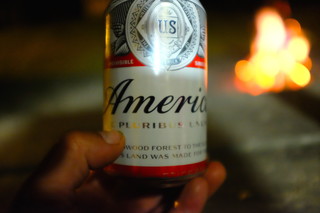
This summer, for the first time in history, Budweiser took its name off its cans. Until the elections are over, it’s been replaced by the word “America.” Each can also features a patriotic quote, such as a line from the national anthem. There’s also one from Woody Guthrie’s song “This Land Is Your Land,” originally intended as a piece of social criticism: “From the redwood forest to the Gulf Stream waters, this land was made for you and me.”
But this land belongs to no one, as I would learn the following day. At best, it belongs to the water.
The heavy storm broke just before the city came into view. We hadn’t been paying attention; we’d been lulled to sleep, looking forward to seeing the Missouri merge with the Mississippi to form a powerful current a third of a mile wide. The thunder woke us. Suddenly we saw whitecaps. It was a great metaphor – the perfect storm – but we needed to get off the water and up onto the steep banks.
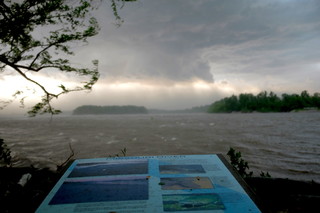
We found some muddy steps at precisely the spot where the two rivers met. We climbed to the top and huddled under a concrete shelter beside plaques about Lewis and Clark.
The river was angry. The heavens boomed. Freshly uprooted stumps sailed by like something out of a sped-up movie. America’s colors had disappeared: all you could see were grays. The opposite bank was gone. It seemed as if the river would wash away the whole country, with all its good and evil, so the people could found it anew.
And do it right, this time.

—Translated from Dutch by Laura Martz and Erica Moore
More from De Correspondent:
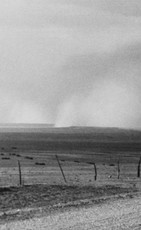
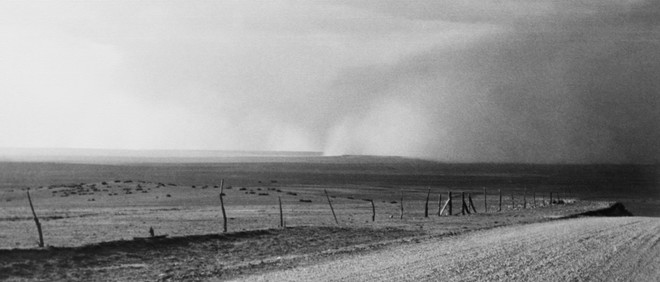 Our fate was sealed long before November 8 (and not because the election’s rigged)
I do not know what kind of America I will wake up to November 9. But I know that the future of America does not hinge on Election Day. What happens to the U.S. will be the cumulative effect of a Trump campaign that has mainstreamed bigotry and is now mainstreaming – or at least severely playing down – white supremacist violence.
Our fate was sealed long before November 8 (and not because the election’s rigged)
I do not know what kind of America I will wake up to November 9. But I know that the future of America does not hinge on Election Day. What happens to the U.S. will be the cumulative effect of a Trump campaign that has mainstreamed bigotry and is now mainstreaming – or at least severely playing down – white supremacist violence.
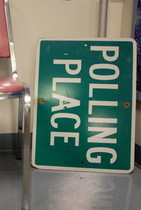
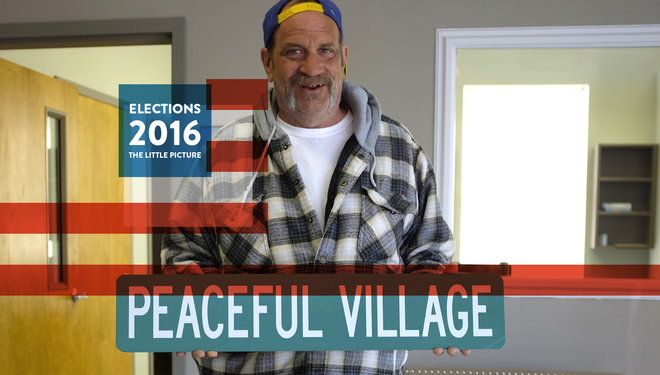 How I tried to cover 605 elections in one day
This election year, instead of following the Big Race, I’ve been talking to everyday Americans campaigning to improve their cities and streets. In April, I set out to cover 605 local races and proposition votes in one day – which turned out to be a big race in itself.
How I tried to cover 605 elections in one day
This election year, instead of following the Big Race, I’ve been talking to everyday Americans campaigning to improve their cities and streets. In April, I set out to cover 605 local races and proposition votes in one day – which turned out to be a big race in itself.
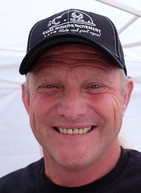
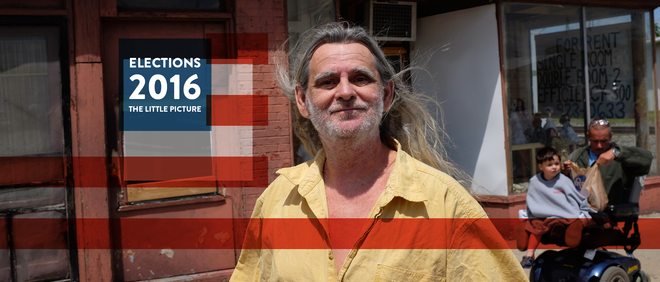 This town is pinning its hopes on a man who’ll Make Coal Great Again
This election year, I’m speaking with ordinary Americans campaigning to improve their streets and towns. Today: Miners looking to make coal great again.
This town is pinning its hopes on a man who’ll Make Coal Great Again
This election year, I’m speaking with ordinary Americans campaigning to improve their streets and towns. Today: Miners looking to make coal great again.



